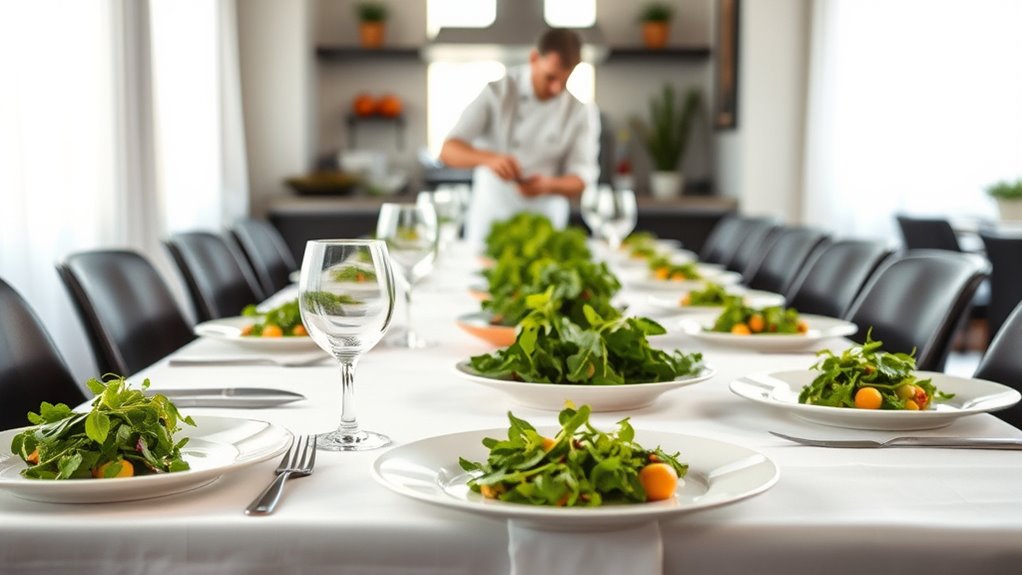Green Michelin restaurants prioritize eco-friendly practices by sourcing ingredients locally to reduce food miles and minimize carbon footprints. They focus on farm-to-table techniques, seasonal menus, and building strong relationships with nearby farmers. This approach not only supports sustainable agriculture but also enhances dish quality. If you want to explore how these innovative restaurants balance fine dining with environmental responsibility, you’ll discover inspiring strategies and real-world examples that show sustainable gastronomy in action.
Key Takeaways
- Green Michelin restaurants prioritize sourcing ingredients locally to minimize food miles and reduce environmental impact.
- They incorporate seasonal, farm-to-table practices supporting sustainable local agriculture.
- Emphasis is placed on transparent sourcing and storytelling to highlight eco-friendly, low food miles practices.
- These establishments adopt energy-efficient operations and waste reduction to enhance overall sustainability.
- They often collaborate with local farmers and participate in community initiatives to promote responsible dining.
The Rise of Sustainable Fine Dining

As diners become more environmentally conscious, sustainable fine dining is gaining momentum worldwide. You’re likely to notice restaurants emphasizing farm-to-table practices, sourcing ingredients directly from local farms to reduce transportation emissions. This approach guarantees freshness while supporting local economies. Many establishments also adopt zero waste strategies, carefully planning menus to minimize food waste and repurposing leftovers creatively. These efforts demonstrate a commitment to reducing environmental impact without sacrificing quality. By choosing restaurants that prioritize sustainable practices, you contribute to a more eco-friendly food industry. This shift reflects a growing awareness of how food choices affect the planet, making your dining experience not only delicious but also responsible. Implementing proper waste management strategies is essential for achieving zero waste goals in these establishments. The rise of sustainable fine dining marks a meaningful step toward greener, more ethical culinary experiences.
Understanding Food Miles and Their Impact
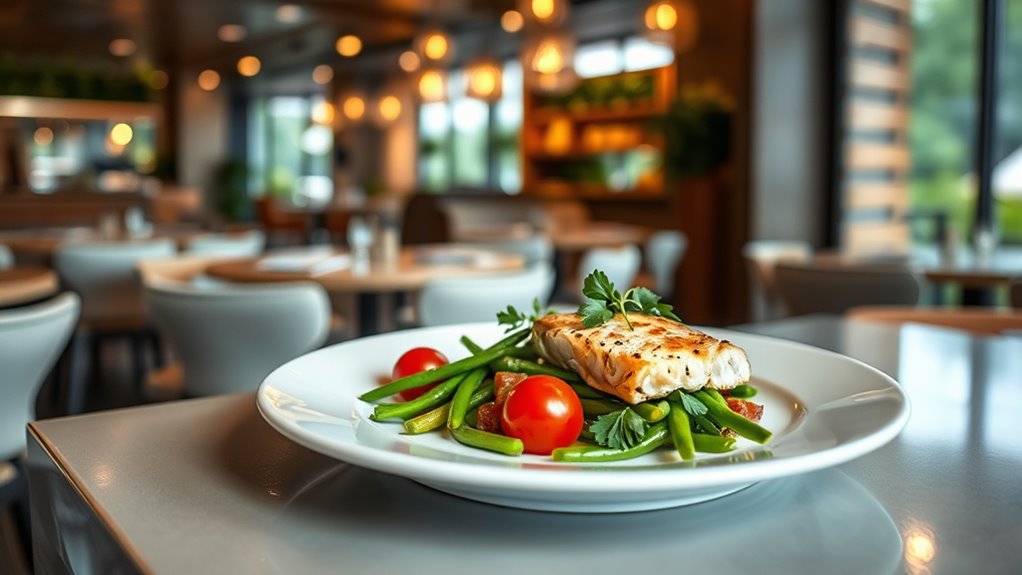
Understanding where your food comes from involves more than just knowing its origin; it also means recognizing the distance it travels before reaching your plate. Food miles measure how far ingredients move through food transportation, impacting environmental footprints. Longer transportation distances often increase carbon emissions and energy use, contributing to climate change. Urban farming plays a crucial role in reducing food miles by growing fresh produce closer to consumers, cutting down on transportation needs. When restaurants source ingredients locally or support urban farms, they lower their environmental impact and ensure fresher, more sustainable dishes. Supporting local food systems can also enhance biodiversity by encouraging diverse agricultural practices and native crop cultivation. By understanding food miles, you can make more eco-conscious choices, supporting systems that prioritize reduced transportation and promote local food production efforts. This awareness helps drive the shift toward greener, more sustainable dining practices.
Sourcing Locally: Strategies for Restaurants
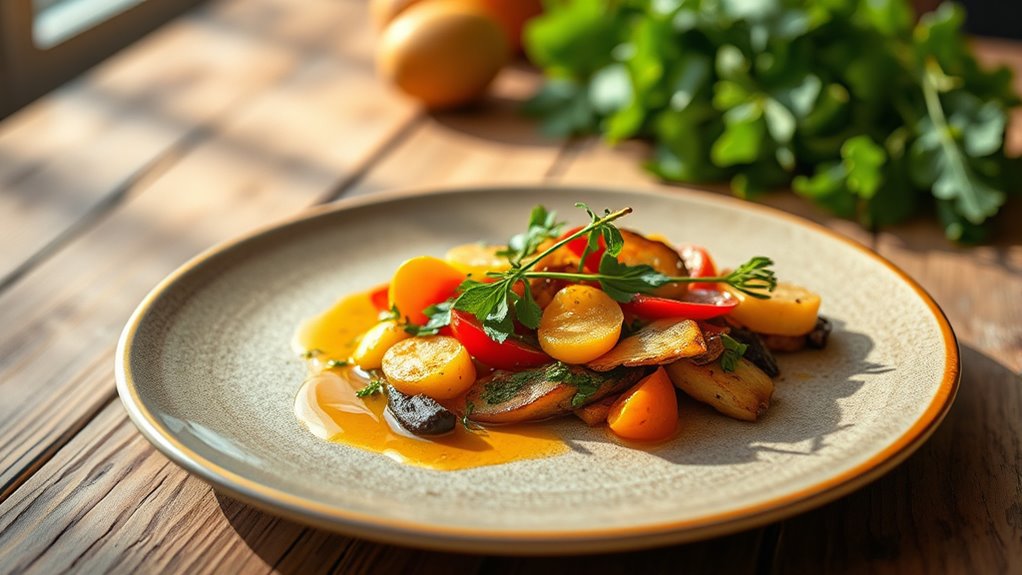
To source locally effectively, you need to build strong relationships with nearby farmers and suppliers. Planning your menu around seasonal produce helps you reduce environmental impact and support local agriculture. By focusing on these strategies, you can create a sustainable, fresh dining experience for your customers. Incorporating electric bikes for delivery can further reduce your restaurant’s carbon footprint and promote eco-friendly practices.
Building Local Networks
Building strong local networks is essential for restaurants aiming to source fresh, quality ingredients while supporting their community. You should prioritize community engagement by attending local events, farmers’ markets, and joining neighborhood associations. These efforts help you connect with nearby farmers, fishers, and artisans, fostering lasting relationships. Establishing local vendor partnerships ensures a reliable supply of seasonal produce, dairy, and meats, reducing food miles and environmental impact. Collaborating with vendors to understand their practices and share your sustainability goals can strengthen your supply chain. Consistent communication and mutual trust build a network that benefits both your restaurant and the local economy. Additionally, understanding the food miles associated with your ingredients can help you make more eco-friendly decisions. By strengthening these relationships, you create a more resilient supply chain that aligns with your commitment to eco-friendly, community-centered dining.
Seasonal Menu Planning
Incorporating seasonal ingredients into your menu begins with thoughtful planning that aligns with your local network of farmers and vendors. By focusing on seasonal ingredients, you can highlight freshness and sustainability while reducing food miles. Flexibility is key; design your menu to adapt to what’s available throughout the year, allowing you to incorporate the best produce at its peak. This approach not only supports local farmers but also keeps your offerings exciting and dynamic for diners. Regularly review your sourcing calendar to anticipate ingredient availability, adjusting dishes accordingly. Embracing seasonal menu planning guarantees you deliver high-quality, environmentally conscious dishes, strengthening your restaurant’s commitment to sustainability and community engagement.
Benefits of Low Food Miles for the Environment
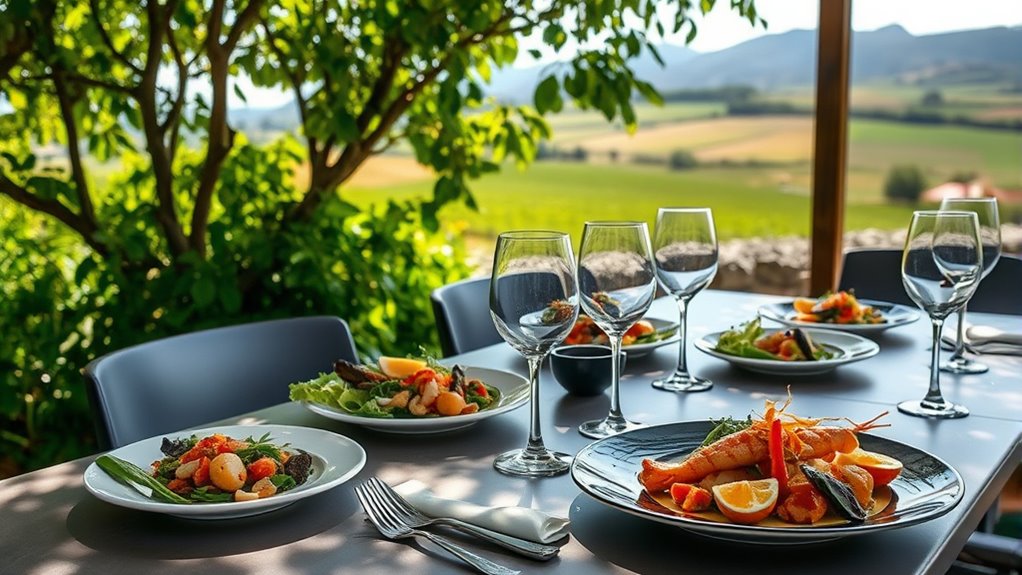
Have you ever considered how the distance food travels impacts the environment? Reducing food miles cuts down on greenhouse gas emissions, helping combat climate change. When food is sourced locally, it supports urban agriculture, which minimizes the need for long-distance transportation. This also promotes food waste reduction, as fresher produce lasts longer and is less likely to spoil during transit. Additionally, shorter supply chains decrease packaging waste and energy consumption. Incorporating office plants into your home or workplace can further improve air quality and create a more sustainable environment.
- Lower transportation emissions help improve air quality and reduce your carbon footprint
- Supporting local farms encourages sustainable farming practices and biodiversity
- Less energy use in logistics preserves natural resources and reduces pollution
Choosing low food miles benefits the environment directly, making your dining choices more sustainable and eco-friendly.
Culinary Excellence Meets Sustainability
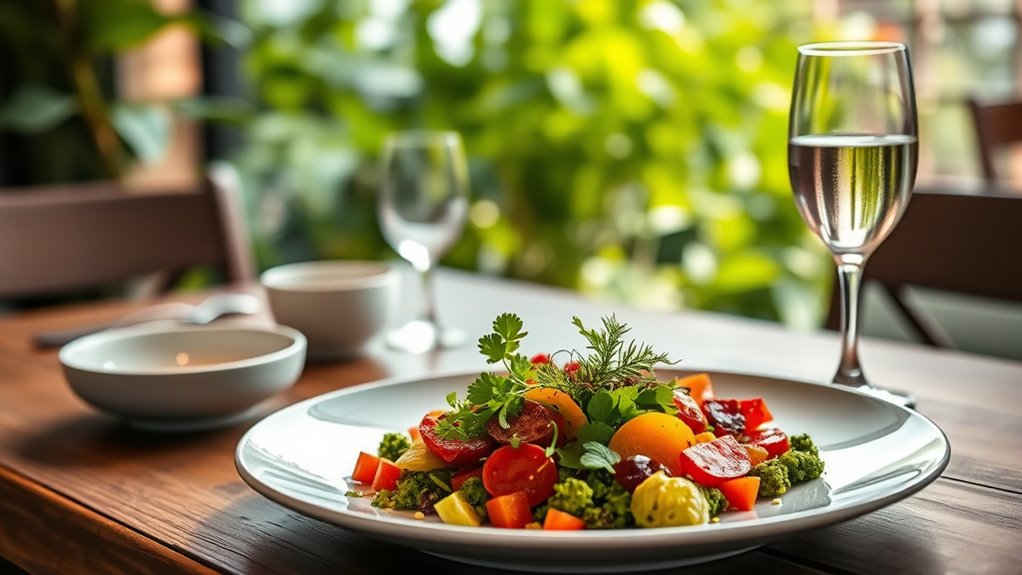
By choosing locally sourced and responsibly produced ingredients, you can enjoy exceptional dishes that also support sustainability. Reducing your culinary footprint helps lower carbon emissions and preserves environmental resources. When you prioritize these practices, you’re making a meaningful impact while savoring top-quality cuisine. Incorporating creative practices into your cooking can further enhance your culinary experience and inspire innovative dishes.
Sourcing Locally and Responsibly
Sourcing ingredients locally and responsibly allows you to deliver exceptional flavors while minimizing environmental impact. By prioritizing ethical sourcing, you guarantee that farmers and suppliers adhere to fair labor practices and sustainable methods. This approach helps reduce food waste, as ingredients are fresher and used more efficiently. When you choose local products, you support your community and lower transportation emissions. Focusing on seasonal produce aligns with sustainability goals and enhances dish quality. Additionally, transparent sourcing practices build trust with diners, emphasizing your commitment to environmental responsibility. Incorporating local and ethical ingredients creates a culinary experience that’s both exquisite and conscientious, demonstrating that fine dining can be both luxurious and eco-friendly. Emphasizing farm-to-table principles can further strengthen your commitment to sustainable and authentic cuisine.
Reducing Carbon Footprint
Focusing on reducing your restaurant’s carbon footprint enhances both environmental sustainability and culinary excellence. You can achieve this by minimizing food waste through careful inventory management and portion control, ensuring nothing goes unused. Implementing energy-efficient appliances and lighting helps lower energy consumption without sacrificing quality. Shift to renewable energy sources where possible, further decreasing your environmental impact. Reducing food waste not only cuts emissions from disposal but also conserves resources used in production. Improving energy efficiency reduces greenhouse gases associated with power generation. Incorporating traditional butter making techniques can also support sustainability by enabling local sourcing and reducing reliance on heavily processed ingredients. These steps demonstrate your commitment to sustainability, resonating with eco-conscious diners. By actively managing food waste and optimizing energy use, you create a greener operation that upholds culinary standards while making a meaningful difference for the planet.
Case Studies of Green Michelin Restaurants
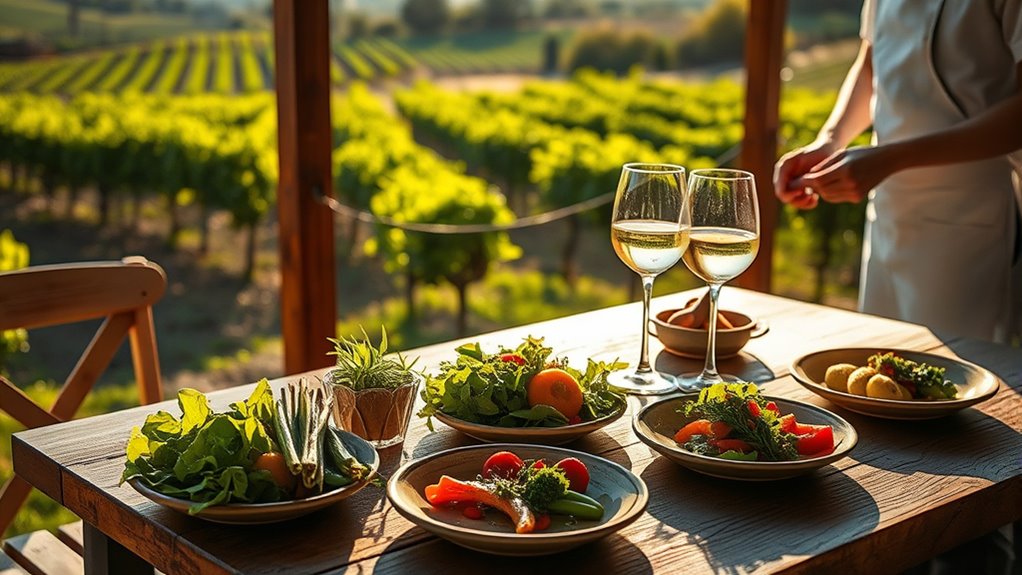
Several restaurants bearing the Green Michelin label showcase inspiring examples of sustainability in action. These establishments prioritize farm to table practices, sourcing ingredients locally to reduce food miles and support local farmers. They also implement zero waste strategies, carefully managing ingredients to minimize waste and composting organic scraps. Incorporating layer textures and colors in their decor helps create a cozy, inviting atmosphere that complements their sustainable ethos. They collaborate directly with nearby farms to ensure freshness and sustainability. They innovate in menu design to utilize every part of ingredients, cutting down on excess waste. They educate diners about eco-friendly practices, encouraging responsible consumption.
Challenges and Opportunities in Eco-Friendly Gourmet Dining
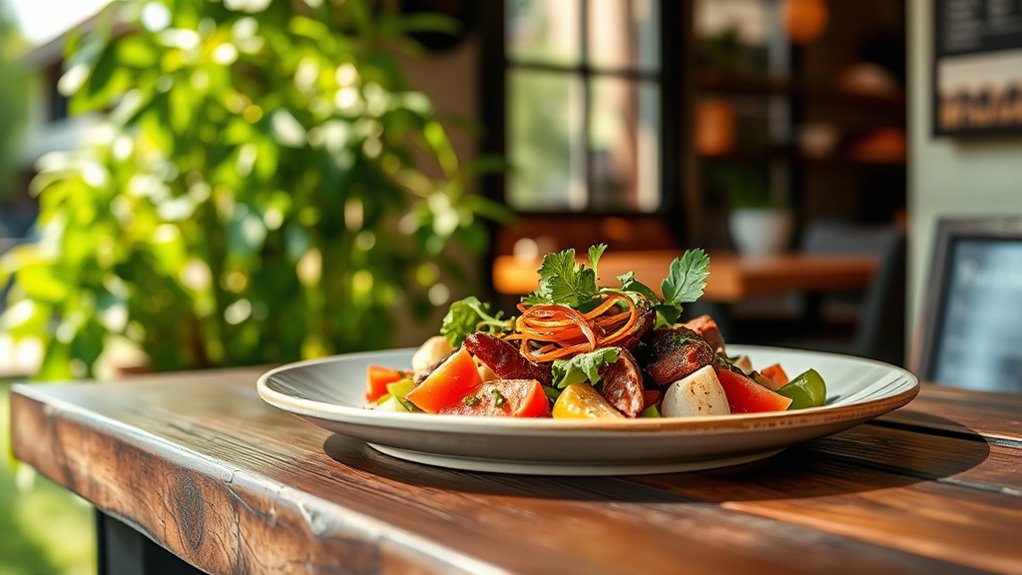
While embracing eco-friendly practices offers significant benefits for gourmet dining, it also presents unique challenges that restaurants must navigate. Implementing plant-based innovations can be costly and require menu adjustments, while sourcing local ingredients might limit variety. Waste reduction demands strict inventory management and staff training, which can be resource-intensive. However, these challenges open opportunities for creativity and differentiation. For example, eco-conscious diners value transparency and innovation. Consider this table:
| Challenge | Opportunity | Solution |
|---|---|---|
| High costs of plant-based ingredients | Attract eco-minded customers | Emphasize sustainability stories |
| Sourcing local produce | Build community support | Partner with local farms |
| Waste management | Enhance efficiency | Implement composting systems |
Future Trends in Sustainable Gastronomy

As the eco-conscious dining movement gains momentum, emerging trends are shaping the future of sustainable gastronomy. You’ll see a stronger emphasis on food education, helping diners understand the environmental impact of their choices. Culinary innovation will push chefs to develop plant-based dishes and utilize alternative ingredients that reduce food miles. Additionally, local sourcing will become even more crucial, fostering stronger connections between farms and kitchens.
- Incorporating transparent sourcing stories to educate customers
- Developing new techniques for zero-waste cooking
- Expanding the use of regenerative agriculture practices
These trends encourage you to participate actively in sustainable eating, making your choices more informed and impactful, while chefs continue to explore creative ways to align gastronomy with environmental responsibility.
Frequently Asked Questions
How Do Green Michelin Restaurants Ensure Ingredient Quality With Local Sourcing?
You can guarantee ingredient quality with local sourcing by building strong relationships with nearby farmers and suppliers. This way, you get fresh, seasonal produce, which guarantees ingredient freshness. Regularly visiting farms, verifying quality standards, and choosing trusted partners help maintain high standards. By prioritizing local sourcing, you’re not only supporting the community but also delivering top-quality dishes that highlight the natural flavors of fresh ingredients.
What Certifications Verify a Restaurant’s Commitment to Low Food Miles?
Like a badge of honor, certifications verify a restaurant’s commitment to low food miles. You should look for environmental certifications like LEAF (Linking Environment And Farming) or local sourcing labels that confirm ingredients are sourced nearby. These certifications guarantee the restaurant reduces carbon footprints and supports sustainable practices. By choosing places with such credentials, you support eco-friendly dining and help protect the environment through responsible sourcing.
How Does Low Food Miles Impact Menu Diversity and Seasonal Availability?
When you focus on low food miles, you tend to prioritize local food and seasonal menus. This approach can limit menu diversity since you rely on what’s available locally at specific times. However, it encourages creativity with seasonal ingredients, making dishes fresh and sustainable. By embracing local food, you support nearby farmers and reduce transportation impacts, creating a menu that highlights seasonal flavors while promoting ecological responsibility.
Are There Cost Differences Between Traditional and Eco-Friendly Fine Dining?
You might notice that eco-friendly fine dining often has a different cost comparison than traditional options. While sustainable ingredients can sometimes be pricier due to sourcing and seasonal constraints, overall, budget considerations vary based on menu choices and sourcing strategies. You should weigh these factors carefully, as eco-friendly practices might require higher upfront investments, but they can also lead to savings through local sourcing and reduced waste.
How Do Green Michelin Establishments Educate Diners About Sustainability?
Imagine a chef gently guiding you through a garden of knowledge, revealing how they champion sustainability. Green Michelin establishments educate diners by highlighting their use of sustainable sourcing and eco-friendly packaging, making it clear that every dish supports the planet. They often share stories about local farms and eco-conscious practices, turning your dining experience into a journey of awareness and appreciation for the environment.
Conclusion
By choosing green Michelin restaurants, you’re supporting a future where fine dining and sustainability go hand in hand, like a perfectly paired wine and dish. Embracing low food miles reduces environmental impact and elevates your culinary experience. As more restaurants adopt eco-friendly practices, you’ll find that luxury and responsibility can coexist beautifully. So, next time you dine out, seek out those committed to sustainability—you’ll taste the difference and help create a greener planet.

